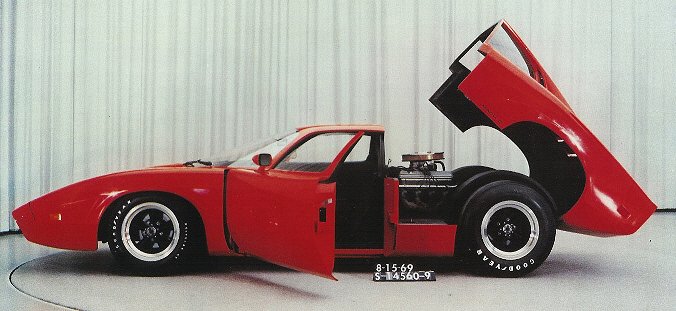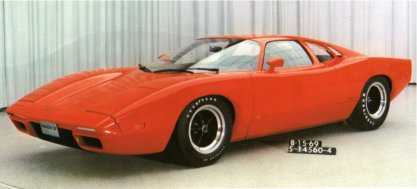Description
The Ford Mach 2C was a striking mid-engine concept car revealed in 1967, a follow-up to the earlier Mach 2A prototype that Ford had shown the same year. At a time when Ford was fresh off its Le Mans victories with the GT40, the company was eager to explore how mid-engine technology could influence its future sports cars, both on the track and potentially for the street. The Mach 2C was the more refined of the two Mach concepts, designed with a sleeker profile and more production-ready styling than its predecessor.
From the outside, the Mach 2C carried the aggressive proportions of a true mid-engine machine. The cockpit was set far forward, with a sharply pointed nose, low stance, and smooth, flowing body lines that gave it an exotic presence. Large air intakes behind the doors fed the engine, while the fastback-style rear deck sloped dramatically down to a set of thin, horizontal tail lamps. Compared to the more experimental Mach 2A, the Mach 2C looked closer to something Ford might realistically have put into production, bridging the gap between the GT40 race car and a possible road-going supercar.
Inside, the Mach 2C retained the minimalist, driver-focused approach of a performance prototype. Deeply bolstered bucket seats, a compact steering wheel, and a dashboard filled with functional instrumentation emphasized its role as a serious driver’s car. The cabin layout reflected racing influence, but Ford’s designers gave it a cleaner, more polished appearance than the spartan interiors of the GT40, suggesting that they envisioned it as a usable road car as well as a high-performance machine.
The Mach 2C was built around the idea of a mid-mounted Ford V8, likely the 289 cubic inch small-block, paired with a manual transaxle. This configuration would have given it excellent balance and strong performance, much like the GT40 but in a more compact and approachable package. While specific output figures were never publicized, the 289 was capable of producing anywhere from 271 to 306 horsepower in high-performance trims, enough to make the lightweight concept a formidable performer had it reached production.
The Mach 2C was shown publicly as part of Ford’s push to experiment with advanced engineering and design directions. At the time, there was real interest inside Ford in producing a mid-engine sports car to capitalize on the success of the GT40 and to challenge European exotics like Ferrari and Lamborghini. However, the idea never progressed beyond the concept stage, as Ford’s focus shifted toward the mass-market Mustang, its derivatives, and continued racing programs. The Mach 2 projects were shelved, leaving the GT40 as Ford’s only true mid-engine success of the era.
Today, the Ford Mach 2C is remembered as one of the most fascinating “what if” cars in Ford’s history. It represented an ambitious attempt to bring mid-engine performance technology to a road-going sports car, years before the idea became mainstream in American automotive design. Though it never made it past the prototype stage, the Mach 2C showed that Ford was willing to think boldly, drawing a direct line between its racing triumphs and the possibility of a production-ready exotic. Its legacy endures as a reminder of how close Ford once came to building a mid-engine supercar decades before the modern Ford GT.

